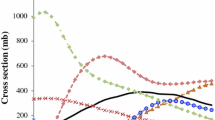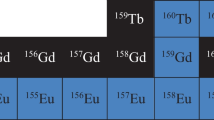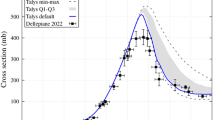Abstract
Application of nanoparticles in nuclear medicine has aimed to develop diagnosis and therapeutic techniques. Cerium oxide nanoparticles (CNPs) are expected to be useful for protection of healthy tissue from radiation-induced harm and could serve therapeutic function. Among a variety of cerium radioisotopes, 137mCe (T 1/2 = 34.4 h, IT (99.22%), β+ (0.779%)) could be a novel candidate radionuclide in the field of diagnosis owing to its appropriate half-life, 99.91% natural abundance of target and its intense gamma line at 254.29 keV. In this study, 137mCe excitation function via the natLa(p,3n) reaction was calculated by TALYS-1.2 and EMPIRE-3 codes. The excitation function calculations demonstrated that the natLa(p,3n)137mCe reaction leads to the formation of the 136/138Ce isotopic contamination in the 22–35 MeV energy range. Interestingly, the isotopic impurities of 137mCe could serve radio protector function. Overall results indicate that the cyclotron produced 137mCeO2 nanoparticles by irradiation of a target encompassing lanthanum oxide nanoparticles could be a potent alternative for conventional diagnostic radionuclides with simultaneous radioprotection capacity.





Similar content being viewed by others
References
Bakht MK, Sadeghi M (2011) Internal radiotherapy techniques using radiolanthanide praseodymium-142: a review of production routes, brachytherapy, unsealed source therapy. Ann Nucl Med. doi:10.1007/s12149-011-0505-z
Mushtaq A (2010) Reactors are indispensable for radioisotope production. Ann Nucl Med 24:759–760
Brown DM (2003) Drug delivery systems in cancer therapy. Humana Press, New Jersey
Das D, Sureshkumar MK, Koley S, Mithal N, Pillai CGS (2010) Sorption of uranium on magnetite nanoparticles. J Radioanal Nucl Chem 285:447–454
Chen C, Du X, Tan X, Wang X (2007) Sorption behavior of Co (II) on γ-Al2O3 in the presence of humic acid. J Radioanal Nucl Chem 273:227–233
Sun YB, Wang Q, Yang ST, Sheng GD, Guo ZQ (2011) Characterization of nano-iron oxyhydroxides and their application in UO22+ removal from aqueous solutions. J Radioanal Nucl Chem. doi:10.1007/s10967-011-1325-2
Chen J, Patil S, Seal S, McGinnis JF (2006) Rare earth nanoparticles prevent retinal degeneration induced by intracellular peroxides. Nat Nanotechnol 1:142–1450
Schubert D, Dargusch R, Raitano J, Chan SW (2006) Cerium and yttrium oxide nanoparticles are neuroprotective. Biochem Biophys Res Commun 342:86–91
Brunner TJ, Wick P, Manser P, Spohn P, Grass RN, Limbach LK et al (2006) In vitro cytotoxicity of oxide nanoparticles: comparison to asbestos, silica, and the effect of particle solubility. Environ Sci Technol 40:4374–4381
Das M, Patil S, Bhargava N, Kang JF, Riedel JM, Seal S et al (2007) Autocatalytic ceria nanoparticles offer neuroprotection to adult rat spinal cord neurons. Biomaterials 28:1918–1925
Tarnuzzer RW, Colon J, Patil S, Seal S (2005) Vacancy engineered ceria nanostructures for protection from radiation-induced cellular damage. Nano Lett 5:2573–2577
Rzigalinski BA, Bailey D, Chow L, Kuiry SC, Patil S, Merchant S et al (2003) Cerium oxide nanoparticles increase the lifespan of cultured brain cells and protect against free radical and mechanical trauma. FASEB J 17:A606
Colon J, Herrera L, Smith J, Patil S, Komanski C, Kupelian P et al (2009) Protection from radiation-induced pneumonitis using cerium oxide nanoparticles. Nanomed Nanotechnol Biol Med 5:225–231
Kuchma MH, Komanski CB, Colon J, Teblum A, Masunov AE, Alvarado B, Babu S, Seal S, Summy J, Baker CH (2010) Phosphate ester hydrolysis of biologically relevant molecules by cerium oxide nanoparticles. Nanomed Nanotechnol Biol Med 6:738–744
Colon J, Hsieh N, Ferguson A, Kupelian P, Seal S, Jenkins DW, Baker CH (2010) Cerium oxide nanoparticles protect gastrointestinal epithelium from radiation-induced damage by reduction of reactive oxygen species and upregulation of superoxide dismutase. Nanomed Nanotechnol Biol Med 6:698–705
Wang L, Yan R, Huo Z, Wang L, Zeng J, Bao J et al (2005) Fluorescence resonant energy transfer biosensor based on upconversion-luminescent nanoparticles. Angew Chem Int Ed 44:6054–6057
Wang F, Han Y, Lim CS, Lu YH, Wang J, Xu J et al (2010) Simultaneous phase and size control of upconversion nanocrystals through lanthanide doping. Nature 463:1061–1065
Cheng L, Yang K, Zhang S, Shao M, Lee S, Liu Z (2010) Highly-sensitive multiplexed in vivo imaging using PEGylated upconversion nanoparticles. Nano Res 3:722–732
Kovacheva P, Avdeev G (2010) Application of mechanochemical activation for synthesis of uranium–lanthanoid mixed oxides. J Radioanal Nucl Chem 288:221–227
Rai P, Mallidi S, Zheng X, Rahmanzadeh R, Mir Y, Elrington S et al (2010) Development and applications of photo-triggered theranostic agents. Adv Drug Deliv Rev 62:1094–1124
Qaim SM (2010) Radiochemical determination of nuclear data for theory and applications. J Radioanal Nucl Chem 284:489–505
Tel E, Baldik R, Aytekin H, Aydin A (2009) Investigation of the nuclear structure of the Be, Cr and Cu isotopes. Ann Nucl Energy 36:1333–1339
Sadeghi M, Bakht MK, Mokhtari L (2011) Practicality of the cyclotron production of radiolanthanide142Pr: a potential for therapeutic applications and biodistribution studies. J Radioanal Nucl Chem 288:937–942
Herman M, Oblozinsky P (2005) NNDC, Brookhaven National Laboratory. http://www.nndc.bnl.gov/empire219. Accessed September 2005
Herman M, Capote R, Zerkin V, Trkov A, Wienke H, Sin M et al. (2011) EMPIRE: modular system for nuclear reaction calculations (version: 3.0 ARCOLE-2011). https://ndclx4.bnl.gov/gf/project/empire/. Accessed Mar 2011
Belgya T, Bersillon O, Capote R, Fukahori T, Zhigang G, Goriely S et al (2006) Handbook for calculations of nuclear reaction data: Reference Input Parameter Library-2. Tech Rep IAEA-TECDOC-1506. International Atomic Energy Agency, Vienna
Koning AJ, Hilairey S, Duijvestijn M (2009) TALYS-1.2: A nuclear reaction program. User manual, NRG, Netherlands. http://www.talys.eu/download-talys. Accessed 22 Dec 2009
Koning AJ, Rochman D (2010) http://www.talys.eu/tendl-2010. TENDL-2010: TALYS-based Evaluated Nuclear Data Library. Nuclear Research and Consultancy Group (NRG) Petten, The Netherlands
Ziegler JF, Ziegler MD, Biersack JP (2010) SRIM—the stopping and range of ions in matter. Nucl Instrum Methods B 268:1818–1823
Firouzbakht ML, Schlyer DJ, Finn RD, Laguzzi G, Wolf AP (1993) Iodine-124 production: excitation function for the 124Te(d, 2n)124I and the 124Te(d, 3n)123I reactions from 7 to 24 MeV. Nucl Instrum Methods Phys Res B 79:909–910
Sadeghi M, Mokhtari L (2010) Rapid separation of 67, 68 Ga from 68 Zn target using precipitation technique. J Radioanal Nucl Chem 284:471–473
Kakavand T, Sadeghi M, Mokhtari L, Majdabadi A (2010) Zinc electrodeposition on copper substrate using cyanide bath for the production of 66, 67, 68 Ga. J Radioanal Nucl Chem 283:197–201
Jalilian AR, Yari-Kamrani Y, Dehghan MK, Rajabifar S (2008) Preparation and evaluation of [201Tl](III)-DTPA complex for cell labeling. J Radioanal Nucl Chem 275:109–114
El-Said H, Mostafa M, El-Amir MA (2009) Potential use of tungstocerate matrices on the separation of 113mIn from 110mAg relevant to the separation of the cyclotron-produced 111In from its silver target. J Radioanal Nucl Chem 279:263–269
Mirzaii M, Seyyedi S, Sadeghi M, Gholamzadeh Z (2010) Cadmium electrodeposition on copper substrate for cyclotron production of 111In radionuclide. J Radioanal Nucl Chem 284:333–339
Nayak D, Lahiri S (2002) Production of tracer packet of heavy and toxic elements. Radioanal Nucl Chem 254:619–623
Mioduski T, Hao DA, Luan HH (1989) Separation of cerium from other lanthanides by leaching with nitric acid rare earth(III) hydroxide-cerium(IV) oxide mixtures. J Radioanalytical Nucl Chem 132:105–113
Riedel A (1970) Radiochemical study of the separation of cerium(III) from lanthanum by solvent extraction using N-benzoyl-N-phenylhydroxylamine. Radioanalytical Nucl Chem 6:75–82
Goswami D, Das AK (2004) Separation of lanthanum and cerium on modified fly ash bed. J Radioanalytical Nucl Chem 262:745–749
Payne RF, Schulte SM, Douglas M, Friese JR, Farmer OT, Finn EC (2011) Investigation of gravity lanthanide separation chemistry. J Radioanalytical Nucl Chem 287:863–867
Naught M, Wilkinson A, Nic M, Jirat J, Kosata B, Jenkins A (2006) IUPAC, compendium of chemical terminology. XML on-line corrected version: http://goldbook.iupac.org. ISBN 0-9678550-9-8. doi:10.1351/goldbook
Zielhuis SW, Seppenwoolde JH, Mateus VP, Bakker CJ, Krijger GC, Storm G et al (2006) Lanthanide-loaded liposomes for multimodality imaging and therapy. Cancer Biother Radiopharm 21:520–527
Acknowledgments
The authors wish to express their thanks to Dr. Parvin Sarabadani of the Nanochemistry Laboratory, Agricultural, Medical and Industrial Research School, Iran for very useful discussions. Additionally, the authors would like to thank Mr. Mahdi Bakhtiari of Department of physics, Persian Gulf University, Iran for his supports in the MATLAB®-base calculations of this work. Finally, the authors would like to express their sincere thanks to Dr. Roberto Capote Noy of IAEA Nuclear Data Section, Vienna, Austria for his useful advice on application of the EMPIRE code. This research was supported by WCU (World Class University) program through the National Research Foundation of Korea funded by the Ministry of Education, Science and Technology (R31-2008-10029).
Author information
Authors and Affiliations
Corresponding author
Additional information
An erratum to this article can be found online at http://dx.doi.org/10.1007/s10967-013-2485-z.
Rights and permissions
About this article
Cite this article
Bakht, M.K., Sadeghi, M. & Tenreiro, C. A novel technique for simultaneous diagnosis and radioprotection by radioactive cerium oxide nanoparticles: study of cyclotron production of 137mCe. J Radioanal Nucl Chem 292, 53–59 (2012). https://doi.org/10.1007/s10967-011-1483-2
Received:
Published:
Issue Date:
DOI: https://doi.org/10.1007/s10967-011-1483-2




